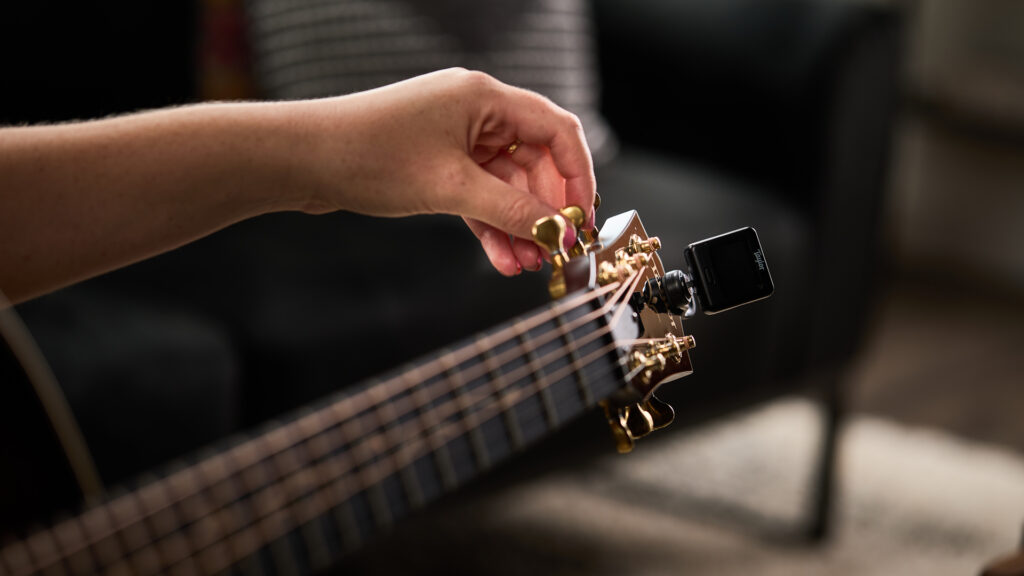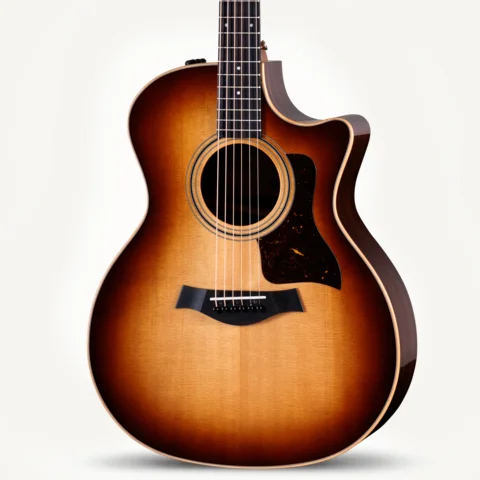An in-tune guitar is the foundation on which guitar music sits—from beginner chords in the bedroom to the world’s most famous solos. No skill is more fundamental for a guitar player than tuning, and the sooner you find yourself comfortable with tuning acoustic guitars, the sooner you can start jamming to your favorite songs.
Thankfully, acoustic guitar tuning is a simple skill you can pick up in your first few days. To that end, we’ve designed this comprehensive guide on how to tune a6 string acoustic guitar. After you’re done, you should be on your way to mastering this key part of your learning experience.
How Tuning a Guitar Works
Before you begin tuning your guitar for the first time, it’s helpful to understand the mechanics and physics at play.
To maintain tension, guitar strings are anchored to the instrument in two places. On a steel-string acoustic guitar, one end of the string is fed into a hole in the bridge and held in place by a bridge pin. The other end is coiled around the tuning posts on the headstock. With a nylon-string guitar, the strings are instead tied to the bridge and wrapped around a tuning machine at the headstock.
Regardless of the guitar string type, the tuning pegs are used to control the tension of the strings. Tension corresponds to pitch, in which tightening a string increases the tension and raises (or sharpens) the pitch. Loosening a string will lower (or flatten) the note. This is because sound is essentially a pressure wave transmitted through the air to our ears. A tighter string vibrates faster, creating waves that are closer together (or more frequent) and therefore higher in pitch (or frequency).
Releasing tension, then, results in a lower pitch. So does increasing the diameter of the string (also called string gauge), which is why guitar strings vary in thickness.
The thicker the guitar string, the slower the vibration, and the lower the pitch.

Acoustic Guitar Tuning: The Basics
The most commonly known way to tune an acoustic guitar is called standard tuning, and you’ll find it in all styles of popular music. From the thickest string to the thinnest one, the notes of standard tuning are EADGBE. There are a handful of mnemonic devices players use to remember these notes. We’ve listed some of the best-known ones below, but feel free to curate your own:
- Eddie Ate Dynamite, Good Bye Eddie
- Elephants Are Darn Good Banana Eaters
- Eat All Day Get Big Easy
Strings are also referred to by numbers, where the topmost, lowest string (E) is the sixth string, the next string (A) is the fifth string, and so on. As you tune each of these strings, remember that turning the tuning peg away from you will tighten the string, thus raising the pitch. Inversely, turning the tuning peg towards you will loosen the string and lower the pitch.
Whenever you tune your guitar, tune up to pitch rather than down. Even if a note is sharp, loosen the string past the desired note until it’s flat, then tune up from there. Tuning up to pitch helps you stay in tune, as the gears inside the tuning pegs are less likely to move afterward and throw your string out of tune.

Methods for Tuning a Guitar
Once you understand the fundamentals of the tuning process, there are a few different ways to go about it. There’s no “right” or “wrong” way to tune a guitar, so try experimenting with these options to see what works best for you.
Using a Guitar Tuner or Tuner App
The handiest tool for beginners is the chromatic tuner. These tuners “listen” to the note you play and guide you to the right pitch via a display screen. For example, if you pluck the B string and the note is flat, a marker from the chromatic tuner will appear to the left of the center line, and you’ll tighten the tuning peg until that marker lines up with the note at the middle.
Chromatic tuners come in a variety of options, such as:
- Clip-on Tuners – A guitar tuner that clips onto the headstock—such as the Taylor Clip-on Tuner or the Snark—are popular, especially among acoustic players. That’s because no cables are required; the tuner senses the pitch through the vibration of the strings. Check out a visual guide on how to use a clip-on tuner here.
- Pedal Tuners – Stompbox-style guitar tuners, also called pedal tuners, are an industry standard for all kinds of players. Plug your guitar into the pedal with a guitar cable, and the display lights up. You’ll find popular models like the Korg Pitchblack or the BOSS TU-3 on just about every pedalboard. Note that these tuners aren’t equipped with a microphone, so you’ll need a guitar with a pickup to use them.
- Strobe Tuners – This electric tuner is in a category of its own, as it comes in pedal, clip-on, or even rack form. Strobe tuners still “listen” to the string pitch, but in place of a needle moving back and forth, they have a strobe that flashes at the same frequency as an in-tune note. To use a strobe tuner, keep adjusting the string’s pitch until the strobe appears to stop moving.
- Apps – For the guitarist on the go, tuner apps are a blessing. Apps like Guitar Tools use your phone’s microphone to pick up sound and allow you to tune your guitar anywhere.
One last tip for using chromatic tuners: ensure you’ve set it to A440Hz unless a song specifies otherwise. A440Hz refers to the frequency of the A above middle C on a piano and is standard in the music world—most tuners will come with this as the default setting.
Matching Pitch With a Piano
If you happen to have a piano or keyboard available, you can use it to tune your guitar by matching the pitch of the keys. This method is especially helpful if you’ll be playing along to the piano since you’ll be in tune with each other. Tuning to a piano requires a bit of piano theory, but it’s a rewarding process that also helps train your ear to recognize pitch.
Tuning by Ear
In a pinch, you can tune a guitar to itself. It may not be “in tune” in the truest sense if you don’t have a proper reference note, but the guitar will at least sound in-tune for a few songs around the campfire. There are two methods for tuning a guitar by ear:
- Fifth fret/open string – The note at the fifth fret of one string should be the same as the open string below it. Play the fifth fret of the sixth string (E), and you have an A. You can then tune the open A string to match. You can work your way down the neck and do this on each string except G—the fourth fret of the G string will give you your B.
- Harmonics – Guitar harmonics are played by lightly resting a fingertip on the string above certain frets. Common harmonics are at the 5th, 7th, and 12th frets. Just like in the method above, a guitar player can use harmonics to tune two strings to each other.
A fifth fret harmonic on one string will sound identical to a seventh fret harmonic played on the string below it. If you play the two simultaneously and they’re out of tune, you’ll hear an oscillating sound. Adjust the pitch until there is no “wobbling” between the two notes. Once again, the exception is when tuning your B string to your G—you’ll need to use the method above for that interval.

Tips for Keeping Your Guitar in Tune
Now that you’ve tuned your guitar for a show or for some practice time, you’ll want to do everything you can to keep it that way. Here are a few tips to help you stay in tune:
- Stretch your strings – Any time you restring your guitar, take a few minutes to gently stretch the strings. With your thumb and forefinger, lightly lift the string away from the fretboard a few times, then tune it again. Do this around two or three times for each string so you won’t have to worry about them stretching out while you play.
- Use high-quality strings – A set of high-quality strings will do wonders for keeping a guitar in tune. Every steel-string Taylor guitar comes out of the factory with Elixir NANOWEB strings.
- Tune often – Keeping your guitar tuned—whether onstage or at home—will help you acquaint yourself with the sound of an in-tune guitar. Once you develop an ear for proper tuning, you’ll be able to recognize when your instrument is out of tune and fix the issue.
Staying In-Tune with Taylor
Tuning over and over may feel like a chore at first, but it’s an important habit to build. Whether you’re playing in a band, performing at an open mic, or showing up to a jam night, you’ll need to be in tune to sound good.
Above all, a well-built and properly set-up guitar will be easy to tune and keep in tune. That’s why we focus on craftsmanship—so you can focus on playing.
Looking for more beginner tips and tricks? Discover how to hold a guitar pick, learn more about Taylor body shapes, and more from the Taylor blog.






















































